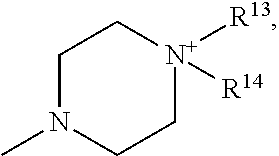Gentle bleaching agent
a bleaching agent and gentle technology, applied in the direction of detergent compounding agent, halogen oxide/oxyacid, other chemical processes, etc., can solve the problems of textile oxidative damage risk, and the difficulty of using transition metal catalysts in detergents in the pas
- Summary
- Abstract
- Description
- Claims
- Application Information
AI Technical Summary
Benefits of technology
Problems solved by technology
Method used
Image
Examples
examples
[0071]Spherical polyelectrolyte brushes (SPBs) with a polystyrene core and acrylic acid grafted onto them were produced by the method described by X. Guo, A Weiss and M. Ballauff in Macromolecules, 1999, pages 6043-6046. An aqueous dispersion of an SPB produced in this way was diluted with water to a solids content of 1 wt %; 25 mol %, based on the molar functional group content in the polyelectrolyte shell, of 1,4,7-trimethyl-1,4,7-triazacyclononane-manganese complex, Mn-Me3TACN, was added at room temperature and pH 5 while stirring, whereupon the Mn-Me3TACN was added by controlled ion exchange via ultrafiltration or simply as a solid powder. The mixture was stirred for 24 hours. Next the SPBs loaded with the catalyst were isolated by centrifugation.
[0072]Primary detergency and loss of wet tensile strength were tested in a miniaturized washing test. The test was conducted using a simplified washing solution V1 consisting of aqueous H2O2 and SPB-Mn-Me3TACN composite particles. A mix...
PUM
| Property | Measurement | Unit |
|---|---|---|
| temperatures | aaaaa | aaaaa |
| pH | aaaaa | aaaaa |
| pH | aaaaa | aaaaa |
Abstract
Description
Claims
Application Information
 Login to View More
Login to View More - R&D
- Intellectual Property
- Life Sciences
- Materials
- Tech Scout
- Unparalleled Data Quality
- Higher Quality Content
- 60% Fewer Hallucinations
Browse by: Latest US Patents, China's latest patents, Technical Efficacy Thesaurus, Application Domain, Technology Topic, Popular Technical Reports.
© 2025 PatSnap. All rights reserved.Legal|Privacy policy|Modern Slavery Act Transparency Statement|Sitemap|About US| Contact US: help@patsnap.com



